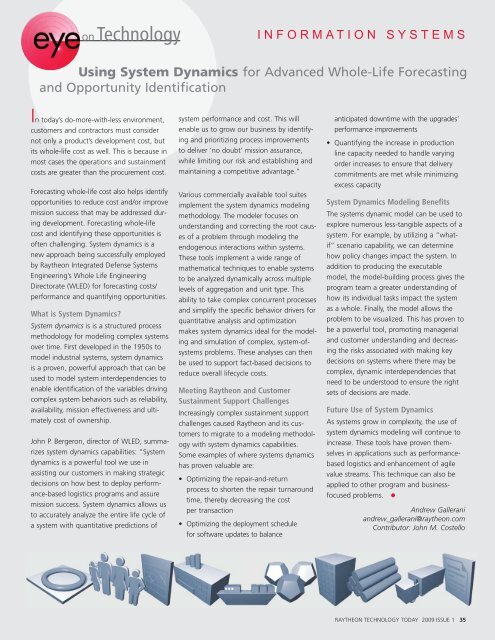2009 Issue 1 - Raytheon
2009 Issue 1 - Raytheon
2009 Issue 1 - Raytheon
You also want an ePaper? Increase the reach of your titles
YUMPU automatically turns print PDFs into web optimized ePapers that Google loves.
onTechnology<br />
INFORMATION SYSTEMS<br />
Using System Dynamics for Advanced Whole-Life Forecasting<br />
and Opportunity Identification<br />
In today’s do-more-with-less environment,<br />
customers and contractors must consider<br />
not only a product’s development cost, but<br />
its whole-life cost as well. This is because in<br />
most cases the operations and sustainment<br />
costs are greater than the procurement cost.<br />
Forecasting whole-life cost also helps identify<br />
opportunities to reduce cost and/or improve<br />
mission success that may be addressed during<br />
development. Forecasting whole-life<br />
cost and identifying these opportunities is<br />
often challenging. System dynamics is a<br />
new approach being successfully employed<br />
by <strong>Raytheon</strong> Integrated Defense Systems<br />
Engineering’s Whole Life Engineering<br />
Directorate (WLED) for forecasting costs/<br />
performance and quantifying opportunities.<br />
What is System Dynamics?<br />
System dynamics is is a structured process<br />
methodology for modeling complex systems<br />
over time. First developed in the 1950s to<br />
model industrial systems, system dynamics<br />
is a proven, powerful approach that can be<br />
used to model system interdependencies to<br />
enable identification of the variables driving<br />
complex system behaviors such as reliability,<br />
availability, mission effectiveness and ultimately<br />
cost of ownership.<br />
John P. Bergeron, director of WLED, summarizes<br />
system dynamics capabilities: “System<br />
dynamics is a powerful tool we use in<br />
assisting our customers in making strategic<br />
decisions on how best to deploy performance-based<br />
logistics programs and assure<br />
mission success. System dynamics allows us<br />
to accurately analyze the entire life cycle of<br />
a system with quantitative predictions of<br />
system performance and cost. This will<br />
enable us to grow our business by identifying<br />
and prioritizing process improvements<br />
to deliver ‘no doubt’ mission assurance,<br />
while limiting our risk and establishing and<br />
maintaining a competitive advantage.”<br />
Various commercially available tool suites<br />
implement the system dynamics modeling<br />
methodology. The modeler focuses on<br />
understanding and correcting the root causes<br />
of a problem through modeling the<br />
endogenous interactions within systems.<br />
These tools implement a wide range of<br />
mathematical techniques to enable systems<br />
to be analyzed dynamically across multiple<br />
levels of aggregation and unit type. This<br />
ability to take complex concurrent processes<br />
and simplify the specific behavior drivers for<br />
quantitative analysis and optimization<br />
makes system dynamics ideal for the modeling<br />
and simulation of complex, system-ofsystems<br />
problems. These analyses can then<br />
be used to support fact-based decisions to<br />
reduce overall lifecycle costs.<br />
Meeting <strong>Raytheon</strong> and Customer<br />
Sustainment Support Challenges<br />
Increasingly complex sustainment support<br />
challenges caused <strong>Raytheon</strong> and its customers<br />
to migrate to a modeling methodology<br />
with system dynamics capabilities.<br />
Some examples of where systems dynamics<br />
has proven valuable are:<br />
Optimizing the repair-and-return<br />
process to shorten the repair turnaround<br />
time, thereby decreasing the cost<br />
per transaction<br />
Optimizing the deployment schedule<br />
for software updates to balance<br />
anticipated downtime with the upgrades’<br />
performance improvements<br />
Quantifying the increase in production<br />
line capacity needed to handle varying<br />
order increases to ensure that delivery<br />
commitments are met while minimizing<br />
excess capacity<br />
System Dynamics Modeling Benefits<br />
The systems dynamic model can be used to<br />
explore numerous less-tangible aspects of a<br />
system. For example, by utilizing a “whatif”<br />
scenario capability, we can determine<br />
how policy changes impact the system. In<br />
addition to producing the executable<br />
model, the model-building process gives the<br />
program team a greater understanding of<br />
how its individual tasks impact the system<br />
as a whole. Finally, the model allows the<br />
problem to be visualized. This has proven to<br />
be a powerful tool, promoting managerial<br />
and customer understanding and decreasing<br />
the risks associated with making key<br />
decisions on systems where there may be<br />
complex, dynamic interdependencies that<br />
need to be understood to ensure the right<br />
sets of decisions are made.<br />
Future Use of System Dynamics<br />
As systems grow in complexity, the use of<br />
system dynamics modeling will continue to<br />
increase. These tools have proven themselves<br />
in applications such as performancebased<br />
logistics and enhancement of agile<br />
value streams. This technique can also be<br />
applied to other program and businessfocused<br />
problems.<br />
Andrew Gallerani<br />
andrew_gallerani@raytheon.com<br />
Contributor: John M. Costello<br />
RAYTHEON TECHNOLOGY TODAY <strong>2009</strong> ISSUE 1 35

















